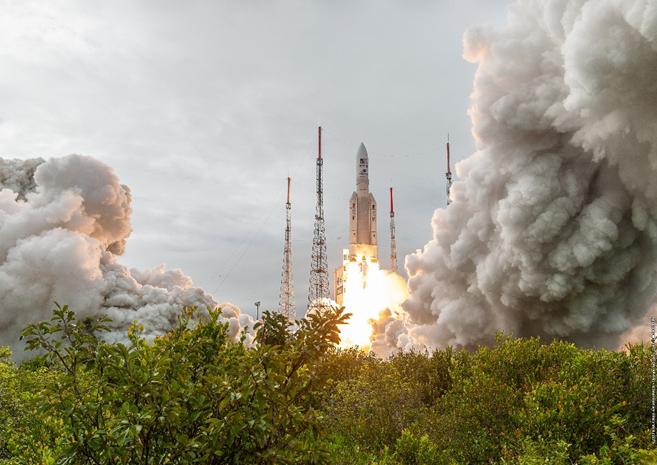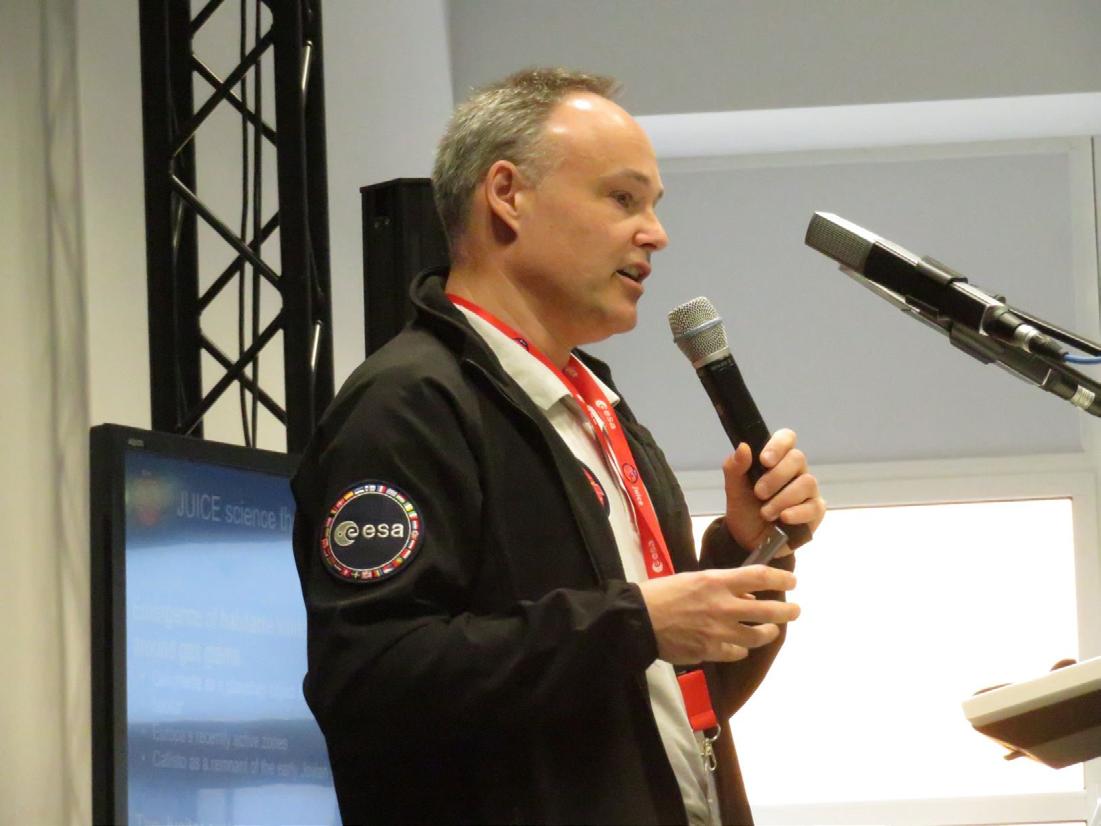
4 minute read
Research Highlight JUICE Mission Updates
History of JUICE selection
The European Space Agency (ESA) issued a call in 2007 to select a flagship mission, to cover the first planning cycle of the new Cosmic Vision programme of the Science Directorate. Then, ESA and NASA began jointly exploring the possibility of a large mission to study the satellite systems of the giant planets. It became clear in the scientific community that the icy moons around giant planets harboured many mysteries that begged for further exploration, in particular potential habitability of the icy satellites. Two mission concepts were considered: the Europa Jupiter System Mission and the Titan Saturn System Mission. After an initial study phase, the Europa Jupiter System Mission was selected for future studies. In 2011, ESA decided on a new way forward for these large mission candidates to take account of developments with ESA’s international partners. During this reformulation exercise, the Europa Jupiter System Mission became JUICE (JUpiter ICy moons Explorer). JUICE was finally selected in 2012 as the first large mission of the Cosmic Vision programme, its payload was selected in 2013, and the mission was adopted in 2014, leading to its development phase with a kick-off of the industrial consortium mid- 2015.
Science objectives
The science objectives for JUICE span a variety of disciplines—from geology, geodesy, geophysics to astrobiology and magnetospheric/plasma and atmospheric science. The high-level goals are to investigate the gas giant, its magnetosphere, the icy moons, and their interrelations in all their complexity. The mission will seek to characterize the conditions that may have led to the emergence of habitable environments around a gas giant, on three Galilean satellites—Ganymede, Europa, and Callisto—that are expected to harbour vast quantities of liquid water underneath their surfaces. Ganymede and Europa in particular are believed to be internally active, due to tidal interactions with Jupiter and to other energy sources present. A particular emphasis is on Ganymede, the largest natural satellite in the solar system, as a planetary body and potential habitat. It provides a natural laboratory for the investigation of a possible habitable world, exhibits unique magnetic and plasma interactions with the surrounding environment, and plays a role in the Laplace resonance with Io and Europa, allowing tidal heating.
The JUICE instrumentation will enable investigation of the formation, evolution, and chemical composition of the planet’s and icy moons’ surfaces and subsurface oceans, and of the processes that have affected the satellites and their environments over time. Study of the subsurface oceans will enhance understanding of their chemical composition and the possible sources and cycling of chemical and thermal energy. The mission will also characterize the diversity of processes in the Jovian system that may provide a stable environment on the icy moons at geologic time scales, including gravitational coupling between the Galilean moons and their long-term tidal influence on the system. This broad exploration will be supplemented by information about Io, minor moons, and dust rings acquired through remote sensing.
To achieve its objectives, the JUICE spacecraft carries 10 state-of-the-art remote sensing, geophysical, and in-situ instruments. It also includes an experiment that uses the spacecraft telecommunication system to be recorded with radio-telescopes.
The building of JUICE
The implementation phase started mid-2015. Besides the programmatic challenges to maintain cost and schedule, the most challenging engineering problems were the solar array performance in a cold and harsh radiation environment, protection of electronics against Jupiter’s radiation environment, electromagnetic cleanliness of the spacecraft to not disturb the sensitive measurements to be obtained by the in-situ payload, and the need to launch with enough propellant to satisfy the very complex trajectory requirements.
In addition, the project had to face the COVID19 situation, and the programmatic difficulties related to the launcher transition from Ariane 5 to Ariane 6.
Despite all these challenges, the spacecraft flight model was declared ready to launch in January 2023 and was transported to French Guyana in early February. A smooth launch campaign took place in February-April.
JUICE launch and commissioning
JUICE was launched on an Ariane 5 from Europe’s Spaceport in Kourou at 14:14 CEST on 14 April 2023. The original launch date was 13 April, however due to bad weather and risks of lightning the event was postponed by one day. All steps during the launch itself went very smoothly. There was a bit of tension when waiting for the first acquisition of signal, even though the first telemetry was detected within the expected time range. Shortly after a so-called "low Earth orbit phase", JUICE went into the commissioning phase for three months, during which time mechanical deployments are executed, and all subsystems and instruments are checked. JUICE has many booms, antennas, and appendages, and the plan was to deploy them in sequence for 17 days, until roughly the end of April. However, a problem occurred when the radar antenna failed to deploy. It took nearly three weeks to understand the fault and to find a proper solution. The problem, a pin holding one of the segments of the radar antenna, was eventually solved by heating the appendages and applying a mechanical shock with another part of the radar antenna to dislodge the stuck pin. The deployment was finally successful on 12 May, which was a huge relief to all the JUICE teams. The rest of the deployments then were successfully completed.
The checks of all subsystems and instruments were successfully executed by early July, and JUICE was declared ready to cruise to Jupiter!
Plans for cruise phase
The official cruise phase starts at the end of the commissioning period (mid-July 2023) and ends six months before the Jupiter orbit insertion planned in July 2031. The nominal science phase will therefore begin in January 2031, when remote observations of Jupiter and in-situ measurements in the solar wind will be regularly acquired.
During the cruise phase, the main milestones will be the four gravity assist flybys: Moon-Earth in August 2024, Venus in August 2025, Earth in September 2026, and January 2029. The instruments will be checked twice per year. Special scientific campaigns (solar wind) are under discussion and will be implemented on a best effort basis.
Stay tuned for the rest of the journey to Jupiter! (see https://twitter.com/ESA_JUICE, www.esa.int/juice and https://cosmos.esa.int/web/juice ).
About the authors
Michele Dougherty is the Principal Investigator for the magnetometer instrument on JUICE and led the Science Definition Team that studied and proposed JUICE to ESA. She is Head of the Physics Department at Imperial College London.

Olivier Witasse is head of the solar system section at the European Space Agency, and the Project Scientist for the JUICE mission.


